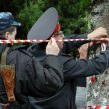
Growing Violence in Kabardino-Balkaria Threatens to Destabilize the Northwest Caucasus
Publication: Eurasia Daily Monitor Volume: 8 Issue: 218
By:

According to the Committee of Inquiry of Kabardino-Balkaria, on November 21, three gunmen were killed during a special operation in Nalchik (the capital of the republic). A source within the security ministries of Nalchik reported that a battle with gunmen occurred on a street of the capital of the republic. The identity of those killed is currently being established (Caucasian Knot, November 21).
The situation in the republic is becoming worse and worse. This year, Kabardino-Balkaria has registered 74 assaults on the lives of law enforcement and members of the military, Valery Ustov, the head of the Investigatory Department (ID) for the Kabardino-Balkarian Republic (KBR) of the Investigatory Committee of the Russian Federation (ICRF), said on November 17.
He noted that the situation in the republic remains complex. This year, 70 suspected militants were liquidated – five times more than last year (16) (Caucasian Knot, November 21). It is noteworthy that in the past year, Kabardino-Balkaria for the first time has had more victims of armed conflict than in neighboring Ingushetia, which had been the epic center of the regional insurgency in previous years. Though 2011 is not over yet, the number of victims of the armed conflict in the republic is higher than in 2010: 137 victims, including 98 casualties and 39 wounded persons in 2011, and 118 victims, including 79 casualties and 39 wounded in 2010 (Caucasus Knot, September 14; Novie Izvestia, January 20). The situation in this recently quiet republic was on a deteriorating trend in 2010, as well. For example, the number of terrorist acts in 2010 was five times as large as in 2009 (Novie Izvestia, November 24, 2010).
Before 2010, the western part of the North Caucasus (Karachaevo-Cherkessia, Kabardino-Balkaria and Adygeia) was much more stable than the eastern part of the North Caucasus (Ingushetia, Chechnya and Dagestan). Militant fighters are trying to spread a guerilla war throughout all of the North Caucasus. The destabilization of the situation in Kabardino-Balkaria is their first success. Many of the militant fighters in Kabardino-Balkaria are ethnic Balkars. Nowadays, the situation in Balkar settlements is close to that of Dagestan and Ingushetia. As in Ingushetia and Dagestan, it is not easy to find any alcohol in Balkar villages because fighters often attack stores selling alcohol. Many Balkar women, under pressure from Islamic militants, have started to wear hijabs (a type of modest dressing covering everything except the face and hands). These facts reflect the growing influence of the militants in the Balkar inhabited areas of the republic.
It is important to note that the stability of the situation in the whole Northwest Caucasus is determined by the political situation in KBR. First of all, this republic has a much larger population than Karachaevo-Cherkessia and Adygeia, and consequently plays a key role in its immediate region. Second (and perhaps more importantly) Kabardino-Balkaria is only a few dozen kilometers from Chechnya.
Interethnic tensions in western North Caucasus also shows signs of worsening as well. The Adygeians, Cherkessians and Kabardins are very close, both in language and culture, and make up a single ethnic community – the Adygs. The Balkars and Karachais are also closely-related peoples and speak the same language – Karachaevo-Balkarian, which belongs to the Turkic family of languages. A “time bomb” was planted back in 1922, when two autonomous republics bordering each other, each of whom had two titular ethnic groups, were created there: Karachaevo-Cherkessia and Kabardino-Balkaria. As a result, both the Adygs, who live on the plains (the Kabardins and the Cherkessians) and the Karachais and Balkars, who live in the mountains, are divided by the borders of the republic.
Relations between the Adygs and the mountain-dwellers have always been rather tense. Karachais and Balkars periodically made raids from the mountains, stealing cattle from the Adygs. In turn, from the 16th to 18th centuries, Adyg princes succeeded in making part of the Karachais and Balkars their vassals, often forcing them to pay tribute.
The situation was exacerbated when Stalin deported the Balkars and Karachais in 1944, together with the Chechens and Ingush. In the consciousness of both peoples, there is a deep-seated opinion, which has been expressed on numerous occasions by their leaders, that the consequences of this deportation have not yet been completely overcome. At the beginning of perestroika, congresses of the Balkar people in Kabardino-Balkaria adopted many resolutions calling for the creation of their own national republic. Congresses of the Circassian people in Karachaevo-Cherkessia also demanded the right to create their own national republic.
Acting together, the sum total of such destabilizing factors as the activities of militant fighters and rising interethnic tensions could eventually exacerbate already deep tensions in the Northwest Caucasus. It also cannot be ruled out that militant fighters might eventually cooperate with other nationalists operating in the North Caucasus. Similar trends showed up already in other parts of the former Soviet Union. A poignant example is the Islamic Movement of Uzbekistan (IMU), which attracted ethnic Uzbek nationalists after Uzbek-Kyrgyz clashes erupted in southern Kyrgyzstan in June 2010 (Novie Izvestia, August 17, 2010).




